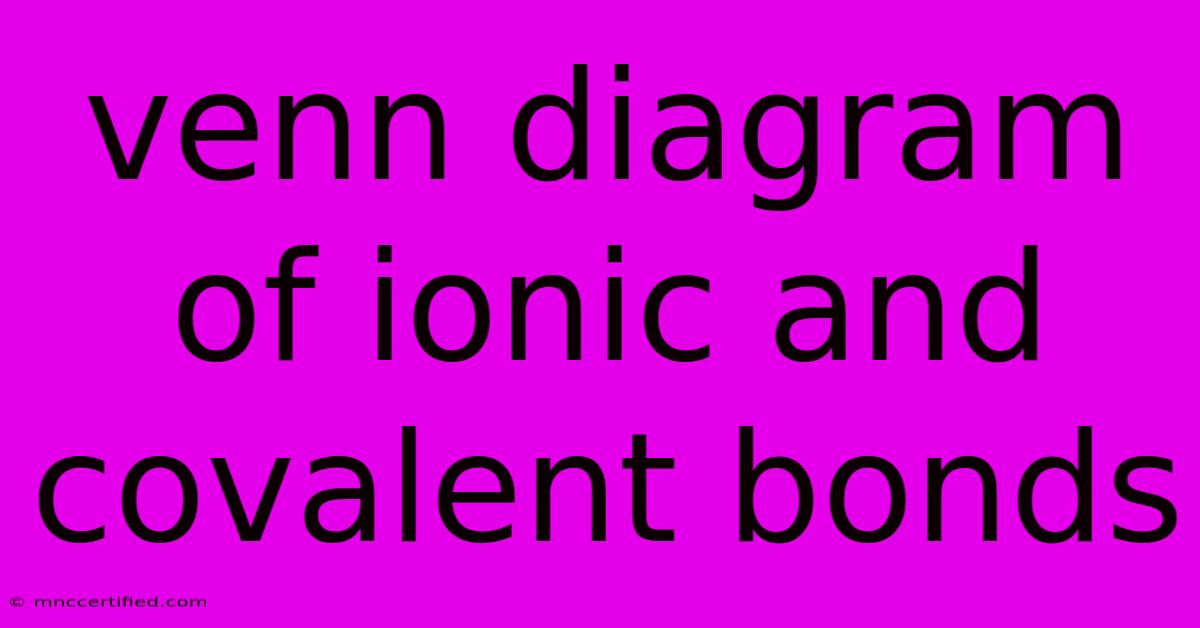Venn Diagram Of Ionic And Covalent Bonds

Table of Contents
Unveiling the Shared and Distinct Features of Ionic and Covalent Bonds: A Venn Diagram Approach
Understanding the fundamental concepts of ionic and covalent bonds is crucial for comprehending the vast world of chemistry. While both involve the sharing or transfer of electrons, they exhibit distinct characteristics that define their behavior. This article will use a Venn diagram to visually illustrate the similarities and differences between these two fundamental bond types, providing a clear understanding of their key features.
Overlap: The Common Ground of Ionic and Covalent Bonds
The Central Overlap: Both ionic and covalent bonds involve the interaction between atoms to achieve a stable electron configuration. This desire for stability drives the formation of chemical bonds, ultimately leading to the formation of molecules or compounds.
Visual Representation:
_________________________
| |
| Sharing/Transfer |
| of Electrons |
|_________________________|
| | |
| | |
Ionic Overlap Covalent
| | | |
|_______|________|________|
Distinctions: Where Ionic and Covalent Bonds Diverge
Ionic Bonds:
- Electron Transfer: Ionic bonds involve the complete transfer of electrons from one atom to another. This transfer creates oppositely charged ions – a positively charged cation and a negatively charged anion.
- Electrostatic Attraction: The bond itself is formed due to the strong electrostatic attraction between these oppositely charged ions.
- High Melting and Boiling Points: Ionic compounds generally possess high melting and boiling points due to the strong electrostatic forces holding the ions together.
- Conductivity: In molten or aqueous states, ionic compounds readily conduct electricity because of the presence of free-moving ions.
Covalent Bonds:
- Electron Sharing: In contrast to ionic bonds, covalent bonds involve the sharing of electrons between atoms. This sharing creates stable electron pairs that contribute to the stability of the molecule.
- Non-Polar and Polar: Covalent bonds can be non-polar (equal sharing of electrons) or polar (unequal sharing of electrons), resulting in a partial positive and partial negative charge on the atoms.
- Low Melting and Boiling Points: Covalent compounds typically have lower melting and boiling points than ionic compounds because the forces holding the molecules together are weaker.
- Non-Conductivity: Covalent compounds generally do not conduct electricity as they lack free-moving charged particles.
Visual Representation:
_________________________
| |
| Sharing/Transfer |
| of Electrons |
|_________________________|
| | |
| | |
Ionic Overlap Covalent
| | | |
|_______|________|________|
|
|
Electron Transfer
|
Electrostatic Attraction
|
High Melting/Boiling Points
|
Conductivity
|
_________________________
| |
| Electron Sharing |
| of Electrons |
|_________________________|
|
|
Non-Polar/Polar
|
Low Melting/Boiling Points
|
Non-Conductivity
Conclusion
By utilizing a Venn diagram, we have successfully illustrated the key similarities and differences between ionic and covalent bonds. This approach provides a clear visual representation, facilitating comprehension and enhancing your understanding of these fundamental concepts in chemistry. Remember, the ability to discern between these bond types is essential for predicting the properties and behavior of various compounds.

Thank you for visiting our website wich cover about Venn Diagram Of Ionic And Covalent Bonds. We hope the information provided has been useful to you. Feel free to contact us if you have any questions or need further assistance. See you next time and dont miss to bookmark.
Featured Posts
-
Scottsdale Insurance Company Phone Number
Nov 07, 2024
-
Should I Clean My Car Before Trading It In
Nov 07, 2024
-
Is Physical Therapy Covered By Insurance
Nov 07, 2024
-
Finding A Girlfriend In Investment Banking
Nov 07, 2024
-
Trevor Sorbie Speaks On Terminal Cancer
Nov 07, 2024